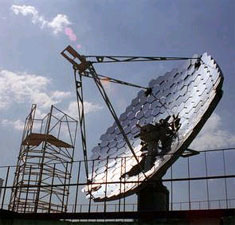India to generate 7,500 MW of power from solar energy
12 Jan 2010
New Delhi: For India, it's time to go solar. Faced with pressing power shortage even as the economy records impressive growth rates, the Indian government plans to incorporate solar energy in a big way as part of its ambitious power generation programme. The government said Monday it would install 20 million solar lights and 20 million square metres of solar panel around the country in a bid to generate an overall 20,000 MW by 2022.
 |
| Solar Collector thermal dish |
''By 2022, we aim to install 20 million square metres of solar thermal collectors and save 7,500 MW power generation capacity,'' he said at the launch of the mission here. ''We want 20 million solar lights to be installed by 2022, which would result in a saving of one billion litres of kerosene every year.''
Official data reveals that renewable energy accounts for a mere 10 per cent of India's total installed generation capacity of 155.8 GW. Most of this clean power is derived from wind turbines and the contribution of solar power is negligible to the overall power output.
''In the next three years, India plans to add 1,300 MW of solar power, of which 1,100 MW will be grid-connected and 200 MW will be off-grid. This is our first benchmark. If we achieve this, achieving the remaining target will not be impossible. A huge constraint in the commercial use of solar energy has been its cost. Today, the initial cost of solar energy is very high, especially for grid power generation. We aim to bring down the cost as quickly as possible,'' Dr. Abdullah said.
As for making the costlier solar power available to the consumer at cheaper rates, Dr Abdullah said the NTPC Vidyut Vyapar Nigam (NVVN) would purchase solar power at rates fixed by the Central Regulatory Electricity Commission. When State utilities bought solar power from the NVVN, they would get an equivalent amount of thermal power. ''The bundling of more expensive solar power with cheaper thermal power will facilitate cheaper tariff for the consumer, estimated to be Rs5, or less, per unit.''






























